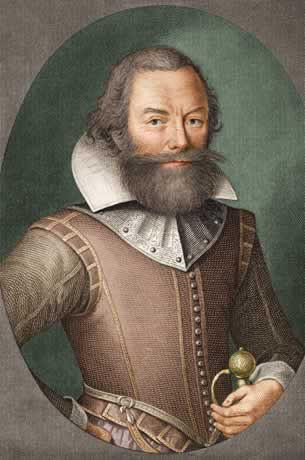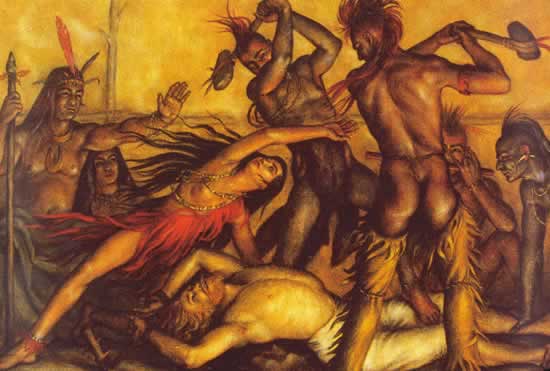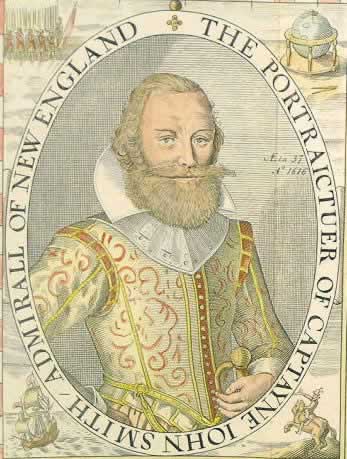Think that you may own a portrait of Captain John Smith? We identify, appraise and issue Certificates of Authenticity (COA) for all portraits of John Smith.

John Smith, Engraved Portrait
Captain John Smith was an English soldier, sailor, and author. He is remembered for his role in establishing the first permanent English settlement in North America at Jamestown, Virginia, and his brief association with the Native American girl Pocahontas during an altercation with the Powhatan Confederacy, and her father, Chief Powhatan. He was a leader of the Virginia Colony (based at Jamestown) between 1607 and 1609, and led an exploration along the rivers of Virginia and the Chesapeake Bay.
His books may have been as important as his deeds, for they encouraged more English men and women to follow the trail he had blazed and colonize the New World. In 1606, Smith became involved with plans to colonize Virginia for profit by the Virginia Company of London, which had been granted a charter from King James I of England. The expedition set sail in three small ships, the Discovery, the Susan Constant and the Godspeed on December 20, 1606.

Statue of John Smith in Jamestown, VA
John Smith was apparently a troublemaker on the voyage, and Captain Christopher Newport (in charge of the three ships) had planned to execute him upon arrival in Virginia. However, upon first landing at what is now Cape Henry on April 26, 1607, sealed orders from the Virginia Company were opened. They designated Smith to be one of the leaders of the new colony, forcing Newport to spare him. The search for a suitable site ended, on May 14, 1607, when Captain Edward Maria Wingfield, president of the council, chose the Jamestown site as the location for the colony.
Harsh weather, lack of water and attacks from Algonquian tribes of the Native Americans almost destroyed the colony. In December 1607, while seeking food along the Chickahominy River, Smith was captured and taken to meet the Chief Powhatan at Werowocomoco, the chief village of the Powhatan Confederacy on the north shore of the York River about 15 miles due north of Jamestown, and 25 miles downstream from where the river forms from the Pamunkey River and the Mattaponi River at West Point, Virginia. Although he feared for his life, Smith was eventually released without harm and later attributed this in part to the chief's daughter, Pocahontas, who, according to Smith, threw herself across his body: "at the minute of my execution, she hazarded [i.e. risked] the beating out of her own brains to save mine; and not only that, but so prevailed with her father, that I was safely conducted to Jamestown".

Pocahontas Saving Captain John Smith from Death in 1607, mural by Paul Cadmus, 1939
Smith's version of events is the only source, and since the 1860s, skepticism has increasingly been expressed about its veracity. One reason for such doubt is that despite having published two earlier books about Virginia, Smith's earliest surviving account of his rescue by Pocahontas dates from 1616, nearly 10 years later, in a letter entreating Queen Anne to treat Pocahontas with dignity. The time gap in publishing his story raises the possibility that Smith may have exaggerated or invented the event to enhance Pocahontas' image. However, in a recent book, Lemay points out that Smith's earlier writing was primarily geographical and ethnographic in nature and did not dwell on his personal experiences, hence there was no reason for him to write down the story until this point.
Henry Brooks Adams, the preeminent Harvard historian of the second half of the 19th century debunked Smith's claims of heroism. He said that Smith's recounting of the story of Pocahontas had been progressively embellished, made up of "falsehoods of an effrontery seldom equaled in modern times." Although there is general consensus among historians that Smith tended to exaggerate his account does seem to be consistent with the basic facts of his life. Adam's attack on Smith was motivated by political considerations coming after the Civil War, an attempt to deface one of the icons of Southern history. Adams' had been influenced to write his fusillade against Smith by John Palfrey who was promoting New England colonization over southern settlement as the founding of America. The accuracy of Smith's accounts has continued to be a subject of debate over the centuries.
Some experts have suggested that, although Smith believed he had been rescued, he had in fact been involved in a ritual intended to symbolize his death and rebirth as a member of the tribe. However, in Love and Hate in Jamestown, David A. Price notes that this is only guesswork, since little is known of Powhatan rituals, and there is no evidence for any similar rituals among other North American tribes.
Whatever really happened, the encounter initiated a friendly relationship with Smith and the colonists at Jamestown. As the colonists expanded further, however, some of the Native Americans felt that their lands were threatened, and conflicts arose again.
In 1608, Pocahontas is said to have saved Smith a second time. Smith and some other colonists were invited to Werowocomoco by Chief Powhatan on friendly terms, but Pocahontas came to the hut where the English were staying and warned them that Powhatan was planning to kill them. Due to this warning, the English stayed on their guard, and the attack never came.
Later, Smith left Jamestown to explore the Chesapeake Bay region and search for badly-needed food, covering an estimated 3,000 miles. He was eventually elected president of the local council in September 1608 and instituted a policy of discipline, encouraging farming with a famous admonishment: "He who does not work, will not eat."
The settlement grew under his leadership. During this period, Smith took the chief of the neighboring tribe hostage and, according to Smith he did, "take this murdering Opechancanough...by the long lock of his head; and with my pistol at his breast, I led him {out of his house} amongst his greatest forces, and before we parted made him [agree to] fill our bark with twenty tons of corn. A year later, full scale war broke out between the Powhatans and the Virginia colonists. Smith was seriously injured by a gunpowder burn after a rogue spark landed in his powder keg. He returned to England for treatment in Oct. 1609, never to return to Virginia.
In 1614, Smith returned to the Americas in a voyage to coasts of Maine and Massachusetts Bay, and named the region "New England". His second attempted voyage to the New England coast in 1615 was interrupted by his capture by French pirates off the Azores. Smith escaped after weeks of captivity and made his way back to England, where he published an account of his two voyages as A Description of New England. He never left England again, and spent the rest of his life writing books. He died in 1631.
There is only one image of Captain John Smith in existence that has been copied many times. This does not mean, however, that new paintings or sketches of the sea captain could not turn up somewhere, perhaps in a sketch book or journal somewhere.

Portrait of John Smith
Still wondering about a portrait in your family collection? Contact us... it could be a portrait of Captain John Smith.
